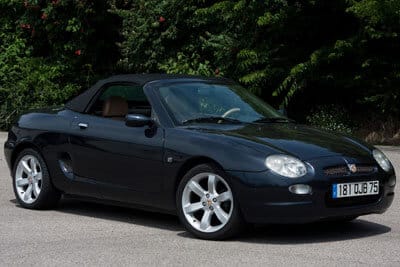Specifications for the 2001 MG F
Read through these items to learn a little more about what it’s like to drive this car.
Rating Scale:
1= Handles and drives like a Model T
10=Handles and drives like a modern car
| Description | 2-seater modern English sports car about the size of the Mazda Miata | |
| Speed | 1.8 liter, 4-cylinder, 120hp- provides more than enough power for the rally | Rating= 8 |
| Brakes | 4-wheel hydraulic brakes are excellent | Rating= 9 |
| Handling | Firm ride and good handling | Rating= 8 |
| Transmission | 5-speed manual, shifts well | Rating= 9 |
| Visibility | Good | |
| Safety | 3 point seatbelts | |
| Passengers | 2 in the front – the cabin is of moderate size | |
| Climate Control | Heat | |
| Quirks | None | |
| Driver Position | Left-hand drive | |
| Overall Rating | 8 out of 10 |

